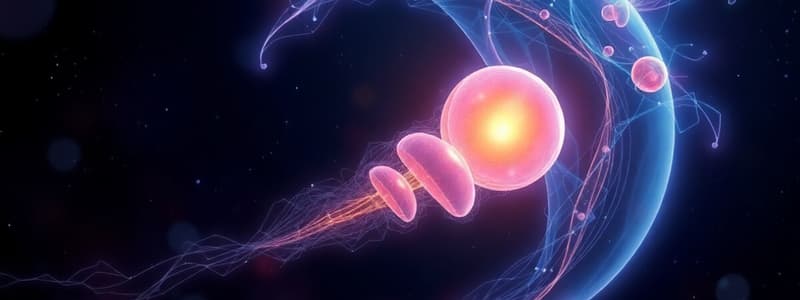Podcast
Questions and Answers
What is the primary role of the trophoblast during early embryonic development?
What is the primary role of the trophoblast during early embryonic development?
- To create the amniotic fluid for the embryo
- To help the embryo attach to the uterine wall and to form part of the placenta (correct)
- To provide a nutrient source for the embryo
- To generate the heartbeat of the embryo
What is the function of the syncytiotrophoblast during implantation?
What is the function of the syncytiotrophoblast during implantation?
- To isolate the embryo from maternal tissues
- To directly supply nutrients to the embryo from maternal blood
- To expand and erode maternal capillaries, facilitating maternal blood flow (correct)
- To secrete hormones that inhibit uterine contractions
What hormone does the syncytiotrophoblast produce, and what is its primary role?
What hormone does the syncytiotrophoblast produce, and what is its primary role?
- Luteinizing hormone (LH), which triggers ovulation
- Oxytocin, which stimulates uterine contractions during labor
- Estrogen, which inhibits the immune response against the embryo
- Human chorionic gonadotropin (hCG), which stimulates progesterone release (correct)
How does progesterone contribute to the development of the embryo?
How does progesterone contribute to the development of the embryo?
What structure connects the embryo to the trophoblastic shell and later forms the umbilical cord?
What structure connects the embryo to the trophoblastic shell and later forms the umbilical cord?
What is the primary feature established during the second week of embryonic development?
What is the primary feature established during the second week of embryonic development?
What does the blastocyst consist of during embryonic development?
What does the blastocyst consist of during embryonic development?
At what stage is the bilaminar embryonic disc formed?
At what stage is the bilaminar embryonic disc formed?
Which two layers does the embryoblast differentiate into during the second week?
Which two layers does the embryoblast differentiate into during the second week?
What role does the syncytiotrophoblast play in embryo implantation?
What role does the syncytiotrophoblast play in embryo implantation?
Which cavities develop within the embryonic unit during the second week?
Which cavities develop within the embryonic unit during the second week?
Why is the second week of development referred to as the week of twos?
Why is the second week of development referred to as the week of twos?
What triggers the blastocyst to partially collapse and change its shape during implantation?
What triggers the blastocyst to partially collapse and change its shape during implantation?
Study Notes
Blastulation
- The fertilized egg divides and forms a cluster of cells called blastomeres.
- The blastomeres form a hollow ball called the blastocyst.
- The blastocyst contains an outer layer of trophoblast cells and an inner cell mass called the embryoblast.
- The trophoblast cells contribute to the formation of the placenta.
- The embryoblast cells give rise to the embryo.
Bilaminar Embryonic Disc
- The embryoblast divides into two layers: the epiblast and the hypoblast.
- These two layers form the bilaminar embryonic disc.
- The amniotic cavity and the yolk sac develop around the bilaminar embryonic disc.
Trophoblast Layers
- The trophoblast layer divides into two layers: the cytotrophoblast and the syncytiotrophoblast.
- The cytotrophoblast is the inner layer of the trophoblast.
- The syncytiotrophoblast is the outer layer of the trophoblast and penetrates the uterine wall.
- The syncytiotrophoblast develops vacuoles that fill with blood, forming lacunae.
- The syncytiotrophoblast erodes maternal capillaries and endometrial glands.
- The blood flows through the trophoblast to provide nutrients to the developing embryo.
Implantation
- Happens in the first week of gestation and continues into the second week.
- The endometrial lining thickens and becomes vascular to prepare for the implantation of the blastocyst.
- The placenta develops from the trophoblast.
- The syncytiotrophoblast produces human chorionic gonadotropin (hCG), a hormone that stimulates the corpus luteum to produce progesterone.
- Progesterone maintains the uterine lining, allowing for the continued development of the embryo.
- The connecting stalk develops into the umbilical cord.
Studying That Suits You
Use AI to generate personalized quizzes and flashcards to suit your learning preferences.
Related Documents
Description
Explore the critical stages of early embryonic development in this quiz, focusing on blastulation and the formation of the bilaminar embryonic disc. Understand the roles of blastomeres, trophoblast layers, and the differentiation into epiblast and hypoblast cells. Test your knowledge of these foundational processes in embryology.




